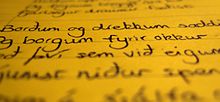|
Eth
 Eth (/ɛð/ edh, uppercase: ⟨Ð⟩, lowercase: ⟨ð⟩; also spelled edh or eð), known as ðæt in Old English,[1] is a letter used in Old English, Middle English, Icelandic, Faroese (in which it is called edd), and Elfdalian. It was also used in Scandinavia during the Middle Ages, but was subsequently replaced with ⟨dh⟩, and later ⟨d⟩. It is often transliterated as ⟨d⟩. The lowercase version has been adopted to represent a voiced dental fricative (IPA: [ð]) in the International Phonetic Alphabet. FaroeseIn Faroese, ⟨ð⟩ is not assigned to any particular phoneme and appears mostly for etymological reasons, but it indicates most glides. When ⟨ð⟩ appears before ⟨r⟩, it is in a few words pronounced [ɡ]. In the Faroese alphabet, ⟨ð⟩ follows ⟨d⟩. Khmer⟨Ð⟩ is sometimes used in Khmer romanization to represent ឍ thô. Icelandic In Icelandic, ⟨ð⟩, called "eð", represents an alveolar non-sibilant fricative, voiced [ð̠] intervocalically and word-finally, and voiceless [θ̠] otherwise, which form one phoneme, /θ/. Generally, /θ/ is represented by thorn ⟨Þ⟩ at the beginning of words and by ⟨ð⟩ elsewhere. The ⟨ð⟩ in the name of the letter is devoiced in the nominative and accusative cases: [ɛθ̠]. In the Icelandic alphabet, ⟨ð⟩ follows ⟨d⟩. NorwegianIn Olav Jakobsen Høyem's version of Nynorsk based on Trøndersk, ⟨ð⟩ was always silent, and was introduced for etymological reasons. Old EnglishIn Old English, ⟨ð⟩ (called ðæt) was used interchangeably with ⟨þ⟩ to represent the Old English dental fricative phoneme /θ/ or its allophone [ð], which exist in modern English as the voiceless and voiced dental fricatives both now spelled ⟨th⟩. Unlike the runic letter ⟨þ⟩, ⟨ð⟩ is a modified Roman letter. Neither ⟨ð⟩ nor ⟨þ⟩ was found in the earliest records of Old English. A study of Mercian royal diplomas found that ⟨ð⟩ began to emerge in the early 8th century, with ⟨ð⟩ becoming strongly preferred by the 780s.[2] Another source indicates that the letter is "derived from Irish writing".[3] Under the reign of King Alfred the Great, ⟨þ⟩ grew greatly in popularity and started to overtake ⟨ð⟩, and did so completely by the Middle English period. ⟨þ⟩ in turn went obsolete by the Early Modern English period, mostly due to the rise of the printing press,[4] and was replaced by the digraph ⟨th⟩. Welsh⟨Ð⟩ has also been used by some in written Welsh to represent /ð/, which is normally represented as ⟨dd⟩.[5] Phonetic transcription
Computer encodingUpper and lower case forms of eth have Unicode encodings:
These Unicode codepoints were inherited from ISO/IEC 8859-1 ("ISO Latin-1") encoding. Modern uses
See also
References
Further reading
External linksWikimedia Commons has media related to Ð. Look up eth in Wiktionary, the free dictionary.
|
||||||||||||||||||||||||||||||||||
